The SSD Relapse: Understanding and Choosing the Best SSD
by Anand Lal Shimpi on August 30, 2009 12:00 AM EST- Posted in
- Storage
Overall System Performance using PCMark Vantage
Next up is PCMark Vantage, another system-wide performance suite. For those of you who aren’t familiar with PCMark Vantage, it ends up being the most real-world-like hard drive test I can come up with. It runs things like application launches, file searches, web browsing, contacts searching, video playback, photo editing and other completely mundane but real-world tasks. I’ve described the benchmark in great detail before but if you’d like to read up on what it does in particular, take a look at Futuremark’s whitepaper on the benchmark; it’s not perfect, but it’s good enough to be a member of a comprehensive storage benchmark suite. Any performance impacts here would most likely be reflected in the real world.
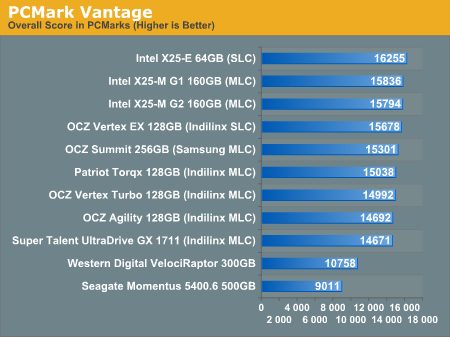
The overall PCMark Vantage score takes into account CPU and GPU performance and thus storage performance is only one aspect of determining your score. All of the SSDs do well here, the slowest configuration still around 36% faster than the WD VelociRaptor; something I'd say is more than reflected in real world performance.
The memories suite includes a test involving importing pictures into Windows Photo Gallery and editing them, a fairly benign task that easily falls into the category of being very influenced by disk performance.
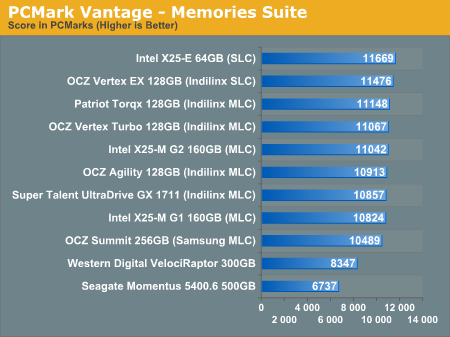
Once again the SSDs all perform very similarly here. The fastest of the group is Intel's X25-E, but the Indilinx drives actually hold the next three spots followed by the new G2. The performance range is very small between these drives though, you honestly can't go wrong with either an Indilinx MLC or X25-M.
The TV and Movies tests focus on on video transcoding which is mostly CPU bound, but one of the tests involves Windows Media Center which tends to be disk bound.
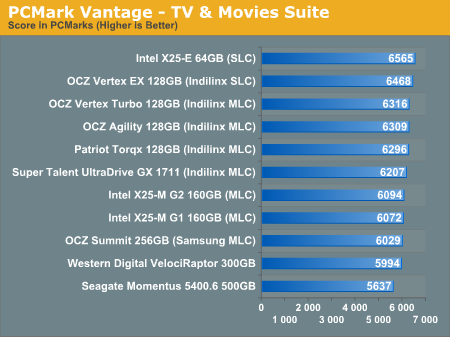
The standings continue to be roughly the same. We see just how much more competitive Indilinx is this time around than when the OCZ Vertex first hit the streets. We do have a real alternative to Intel.
The gaming tests are very well suited to SSDs since they spend a good portion of their time focusing on reading textures and loading level data. All of the SSDs dominate here, but as you'll see later on in my gaming tests the benefits of an SSD really vary depending on the game. Take these results as a best case scenario of what can happen, not the norm.
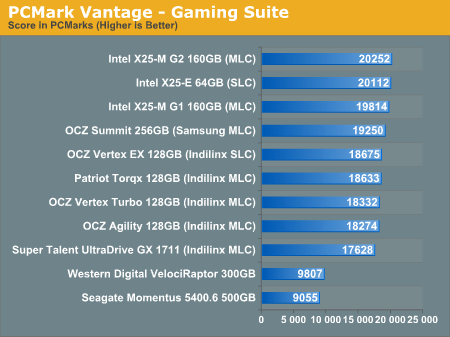
The Vantage Gaming Suite shows us our first example of the X25-M G2 pulling ahead of even the SLC X25-E. Even the Samsung based OCZ Summit does very well here.
In the Music suite the main test is a multitasking scenario: the test simulates surfing the web in IE7, transcoding an audio file and adding music to Windows Media Player (the most disk intensive portion of the test).
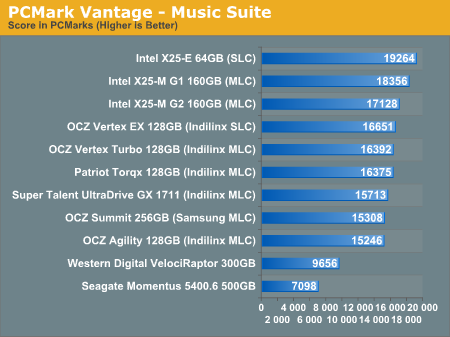
The Intel drives are at the top, the G1 faster than the G2, followed by the Indilinx drives, then the Samsung drive and the mechanical drives. New performance is important here because once TRIM shows up, this is closer to what you'll be seeing for a drive with a good amount of free space.
The Communications suite is made up of two tests, both involving light multitasking. The first test simulates data encryption/decryption while running message rules in Windows Mail. The second test simulates web surfing (including opening/closing tabs) in IE7, data decryption and running Windows Defender.
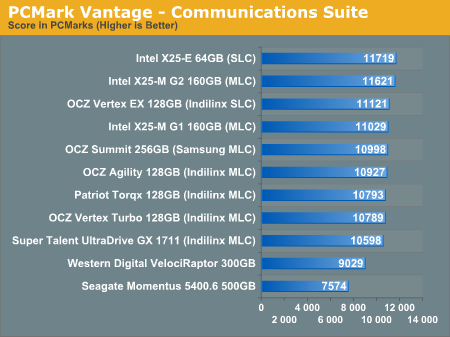
I love PCMark's Productivity test; in this test there are four tasks going on at once, searching through Windows contacts, searching through Windows Mail, browsing multiple webpages in IE7 and loading applications. This is as real world of a scenario as you get and it happens to be representative of one of the most frustrating HDD usage models - trying to do multiple things at once. There's nothing more annoying than trying to launch a simple application while you're doing other things in the background and have the load take seemingly forever.
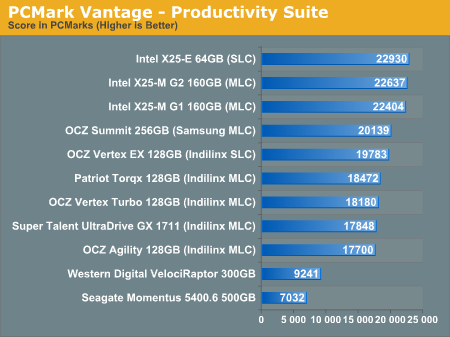
Here the Intel drives are at the top, by a noticeable margin. The G1, G2 and X25-E are all around the same level of performance. Samsung comes close with the OCZ Summit and the Indilinx drives pull up the rear. You can't go wrong with either the Intel or Indilinx drives but Intel is clearly faster here.
The final PCMark Vantage suite is HDD specific and this is where you'll see the biggest differences between the drives:
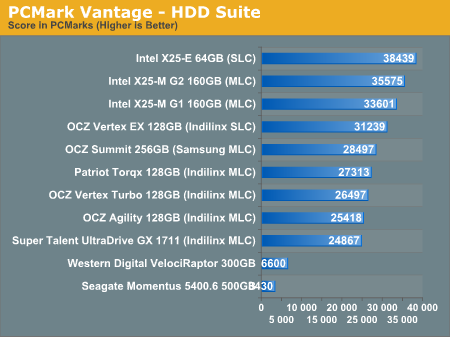
When it comes to pure drive performance, the breakdown doesn't get any simpler. Intel's X25-E holds the top spot, followed by the G2 and G1. While the G2 is only 5.6% faster than the G1, remember that we're looking at "new" performance here. Over time, with TRIM, the G2 will be closer to this performance, while the G1 will never get here again.
Despite poor random small file write performance, the OCZ Summit actually does very well here.
All of the drives perform incredibly compared to any mechanical hard drives.










295 Comments
View All Comments
Wwhat - Sunday, September 6, 2009 - link
If you read the first part of the article alone you would see how important a good controller is in a SSD and you would no ask his question probably, plus SSD's use the flash in parallel where a bunch of USB drives would not, the parallel thing is also mentioned in the article.And USB has a lot of overhead actually on the system, both in CPU cycles as well as in IO interrupts.
There are plug in PCI(e) cards to stick SD cards in though, to get a similar setup, but it's a bit of a hack and with the overhead and the management and controllers used and the price to buy many SD cards it's not competitive in the end and you are better of with a real SSD I'm told.
Transisto - Sunday, September 6, 2009 - link
You are right, the controller is very important.I think caching about 4-8 gig of most often accessed program files has the best price/performance ratio, for improving application load time. It it also very easily scalable.
One of the problem I see is integrating this ssd cache in the OS or before booting so it act where it matter the most.
I think there could be a near x25-m speedup from optimized caching and good controller no matter what SSD form factor it rely on. SD, CF, usb , pci or onboard.
Why it seams nobody talk about eboostr type of caching AND ,,, on other news ,,, Intel's Braidwood flash memory module could kill SSD market.
I am quite of a performance seeker.
But I don't think I need 80gig of SSD in my desktop,just some 8gb of good caching. Mabe a 60gb ssd on a laptop.
Well... I'm gonna pay for that controller once, not twice (160gb?)
Wwhat - Saturday, September 5, 2009 - link
Not that it's not a good article, although it does seem like 2 articles in one, but what I miss is getting to brass tacks regarding the filesystem used, and why there isn't a SSD-specific file system made, and what choices can be made during formatting in regards to blocksize, obviously if you select large blocks on filesystem level a would impact he performance of the garbage collection right? It actually seem the author never delved very deeply into filesystems from reading this.The thing is that even with large blocks on filesystem level the system might still use small segments for the actuall keepin track, and if it needs to write small bits to keep track of large blocks you'd still have issues, that's why I say a specific SSD filesystem migh be good, but only if there isn't a new form of SSD in the near future that makes the effort poinless, and if a filesystem for SSD was made then the firmware should not try to compensate for exising filesystem issues with SSD's.
I read that the SD people selected exFAT as filesystem for their next generation, and that also makes me wonder, is that just to do with licensing costs or is NTFS bad for flash based devices?
Point being at the filesystem needs to be highlighted more I think,
Bolas - Friday, September 4, 2009 - link
Would someone please hit Dell with the clue-board and convince them to offer the Intel SSD's in their Alienware systems? The Samsung SSD's are all that is stopping me from buying an Alienware laptop at the moment.EatTheMeat - Friday, September 4, 2009 - link
Congratulations on another fab masterclass. This is easily the best educational material on the internet regarding SSDs, and contrary to some comments, I think you've pitched your recommendations just right. I can also appreciate why you approached this article with some trepidation. Bravo.I have a RAID question for Anand (or anyone else who feels qualified :-))
I'm thinking of setting up 2 160GB x25-m G2 drives in RAID-0 for Win 7. I'd simply use the ICH10R controller for it. It's not so much to increase performance but rather to increase capacity and make sure each drive wears equally. After considering it further I'm wondering if SSD RAID is wise. First there's the eternal question of stripe size and write amplification. It makes sense to me to set the stripe size to be the same as, or a fraction of, the block size of the SSD. If you choose the wrong stripe size does it influence write amplification?
I'm aware that performance should increase with larger spripes, but I'm more concerned about what's healthy for the SSD.
Do you think I should just let SSD RAID wait until RAID drivers are optimised for SSDs?
I know you're planning a RAID article for SSDs - I for one look forward to it greatly. I've read all your other SSD articles like four times!
Bolas - Friday, September 4, 2009 - link
If SSD's in RAID lose the benefit of the TRIM command, then you're shooting yourself in the foot if you set them up in RAID. If you need more capacity, wait for the Intel 320GB SSD drives next year. Or better yet, use a 160 GB for your boot drive, then set up some traditional hard disk drives in RAID for your storage requirements.EatTheMeat - Friday, September 4, 2009 - link
Thanks for reply. I definitely hear you about the TRIM functionality as I doubt RAID drivers will pass this through before 2010. Still though, it doesn't look like the G2s drop much in performance with use anyway from Anand's graphs. With regard to waiting for 320 GB drives - I can't. These things are just too enticing, and you could always say that technology will be better / faster / cheaper next year. I've decided to take the plunge now as I'm fed up with an i7 965 booting and loading apps / games like a snail even from a RAID drive.I just don't want to bugger the SSDs up with loads of write amplification / fragmentation due to RAID-0. ie, is RAID-0 bad for the health of SSDs like defragmentation / prefetch is? I wonder if anyone knows the answer to this question yet.
jagreenm - Saturday, September 5, 2009 - link
What about just using Windows drive spanning for 2 160's?EatTheMeat - Saturday, September 5, 2009 - link
As far as I know drive spanning doesn't even the wear between the discs. It just fills up first one and then the other. That's important with SSDs because RAID can really help reduce drive wear by spreading all reads and writes across 2 drives. In fact, it should more than half drive wear as both drives will have large scratch portions. Not so with spanning as far as I know.Does anyone know if I'm talking sh1t here? :-)
pepito - Monday, November 16, 2009 - link
If you are not sure, then why do you assert such things?I don't know about Windows, but at least in Linux when using LVM2 or RAID0 the writes spread evenly against all block devices.
That means you get twice the speed and better drive wear.
I would like to think that microsoft's implementation works more or less the same way, as this is completely logical (but then again, its microsoft, so who can really know?).